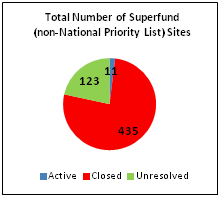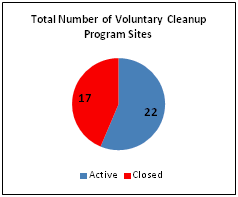June 2016 Metrics Report









Like all states, Nebraska must address contamination resulting from practices of the past. The above graphs summarize the cumulative results from two separate, but related programs. The Voluntary Cleanup Program (VCP) implements the provisions contained in the Remedial Action Plan Monitoring Act passed in 1995. The Act provides a means for property owners or other interested parties to assess, and if necessary clean up contaminated property. Upon successful completion of the approved cleanup plan, NDEQ may issue a letter stating that “No Further Action” is necessary. The letter provides assurances that appropriate actions have been taken thus facilitating redevelopment or reuse of the property.
The Brownfields program is similar in many ways to VCP. The Department has utilized federal Brownfields funding to assess the presence of contamination on a property. If contamination is found, the VCP program has been used to address the contamination and get the property back into productive use. The above graphs summarize the amount of land that has benefited from the programs.








The majority of sites addressed in this report are those that have some degree of groundwater contamination. The contamination is a result of many different operations and practices, everything from the cleanup of load lines at Department of Defense ammunition manufacturing facilities to the fumigation of Department of Agriculture grain storage facilities. The age, nature and severity of the contamination play a role in determining the specific program that will be used to address the contamination. The programs NDEQ relies upon are reflected in the graphs above. (It should be noted that contamination associated with petroleum storage are not included – those sites were addressed in the May report.)
The total number of sites addressed is 949. Undoubtedly there are sites that will be discovered in the future. The sites of greatest significance are the 16 sites listed on the Superfund National Priorities List (NPL). (One of the NPL sites, the Omaha lead site, does not involve groundwater – the contaminant is lead in the soil as the result of operations of the closed Asarco lead refinery.) Typically there is extensive contamination at the NPL sites and cleanup takes several years. This is evident in that only one of the Superfund NPL sites has been closed. Contrast the Superfund NPL cleanups with those addressed by the VCP, which includes NPL-caliber sites enrolled in the program, the VCP is a more streamlined and efficient process for addressing contaminated sites. (More information on each of the programs can be found in NDEQ’s annual report to the legislature.)
Following is a description of specific issues NDEQ has been addressing in June:
Emerging Risks / Issues: A variance to allow Fortigen to construct a large anhydrous ammonia facility just outside of Geneva has been granted. Fortigen will manufacture anhydrous ammonia fertilizer in the facility which will include a very large, over seven-million gallon, storage tank. While Geneva officials have gone on record as supporting the facility there has been some public dissatisfaction expressed over the proposal.
Heritage Disposal and Supply conducted a tour of their existing facility on June 21st. All 12 members of the Site Review Committee participated on the tour. A follow-up meeting was held on June 23rd to discuss the tour and to examine transportation and safety issues associated with the Heritage facility.
Accomplishments: NDEQ has provided funds to Franklin County to reimburse the costs associated with cleaning up an illegal road-side dump. A portion of the funds generated by the fee on depositing waste at landfills is available to address illegal dumping along public right-of-ways. To date, the county has picked up and properly disposed 770 tons of waste. The County has erected fences and built earthen berms in order to prevent dumping in the future.
NDEQ sponsored two outreach events to help the regulated community understand the permitting process. One of the primary objectives was to help applicants complete quality applications so a decision on the application could be made in a timely manner. A session was held for the pork industry in Columbus with 20 attendees, including Nebraska’s two largest pork producers, two NRDs, and the Dept. of Agriculture. A similar session was held in Grand Island for the poultry industry with 15 in attendance, including Hendrix Genetics, UNL Extension, an NRD and prospective producers.
Misc. Items of Note: The Environmental Quality Council met on June 14th in Norfolk. The Council approved proposals on the priority list for the State Revolving Fund, which supports public drinking water and publicly owned wastewater treatment facility projects. The Council approved provisions for a revolving loan program for construction, rehabilitation or enhancement of nonpoint source control systems. Eligible applicants include both public and private entities – eligible projects could include on-site projects, local water protection projects and livestock water quality facility projects. The Council also approved the adoption of federal regulations applicable to nitric acid manufacturing facilities.
All municipal waste landfills are required to participate in a program that ensures funds will be available to address problems that may occur after the landfill is closed, e.g. groundwater contamination. Typically that occurs over a 30-year period. Minden applied for an 18-year post-closure care period, which has now concluded. The Dept. has reviewed the environmental conditions at the landfill and determined that the landfill has caused no environmental harm and that Minden has met its obligations. This is the first landfill in the state to meet post-closure requirements.